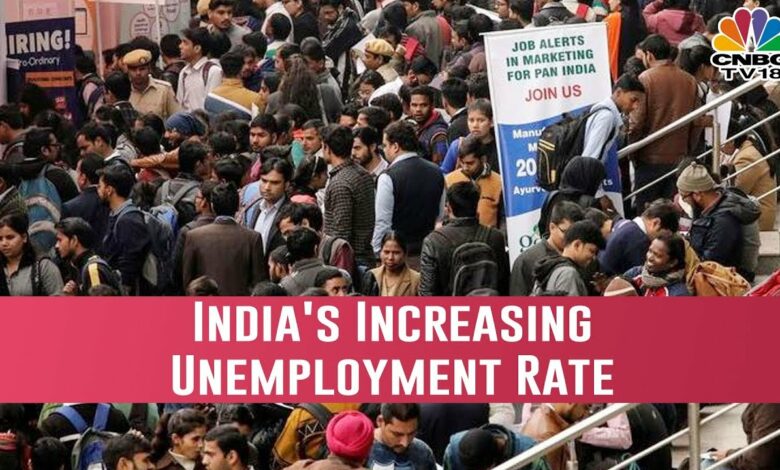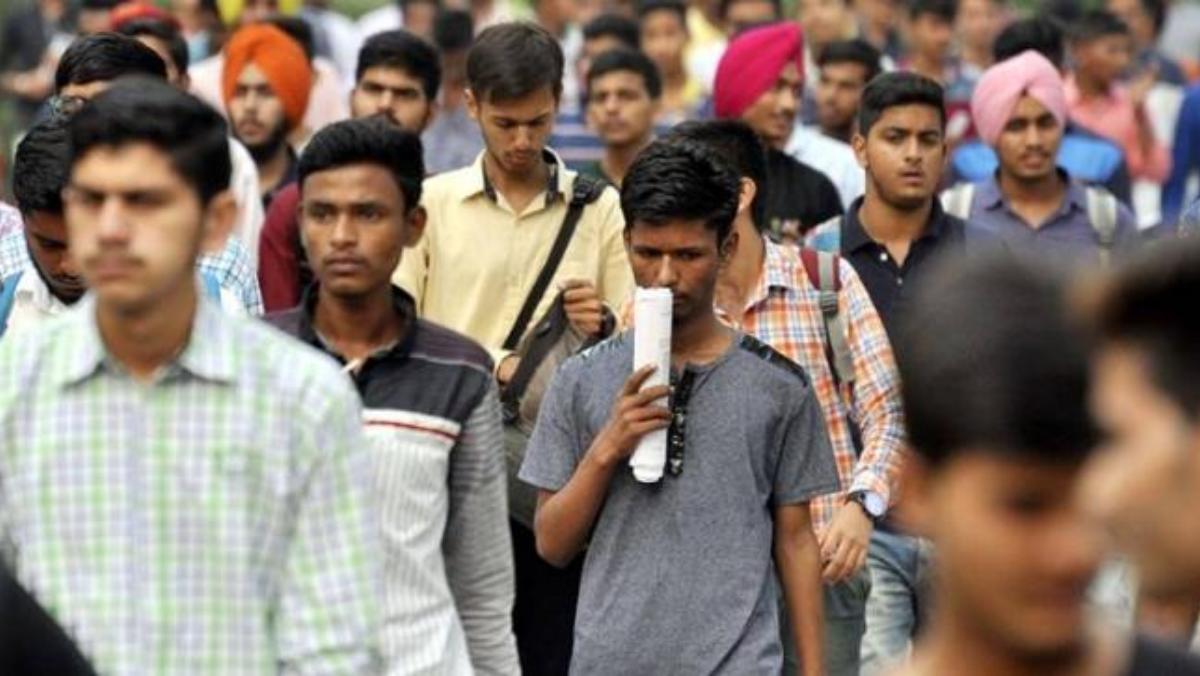What is causing India’s rising unemployment? Budget 2022: Job-less generation in future

What is causing India’s rising unemployment? Budget 2022: Job-less generation in future
What do you think Indian Unemployment is a problem of economics or governance? What is the actual rate of joblessness in this country as reflected by Unemployment? Who is responsible for India’s rising Unemployment? Let’s find out.
During a job interview, Satyajit Ray’s 1972 film, Pratidwandi, features a memorable scene in which the protagonist is quizzed about his “aim in life.”. He replied, “To find a job.”. However, he was turned down.
In the age of the movie on the big screen and the natural world mixing, the United States finds itself in a similar situation where an excessive number of citizens are searching for jobs but cannot see them. Several agencies have reported the unemployment problem. During the Covid lockdowns, most displaced people had not returned to their villages and were jobless, contributing to surplus labour and falling wages.
The National Sample Survey Office found that the country’s yearly unemployment rate increased to 6.1 per cent during 2017-18 from 2.2 per cent in 2011-12, the highest level of Unemployment in four decades. According to the report, Unemployment gripped the economy long before the pandemic in March 2020. The Centre for Monitoring Indian Economy (CMIE) estimates that the unemployment rate increased from 23.5% in April to 21.7% in May following the pandemic.
In December 2021, the percentage was 7.9 per cent in urban areas and 7.28 per cent in rural areas. As of December 2021, India had 53 million unemployed people, of whom 35 million were still seeking employment. The remaining unemployed had lost all hope in the system and didn’t even want to apply for jobs.
Despite its launch in 2014, the Modi government’s Make In India program appears to have faltered after aiming to increase manufacturing employment to 100 million by 2022. Over 71 per cent of the additional workers in 2019-20 came from the agriculture sector, suggesting a shift away from industry to agriculture.
It is only possible to imagine the implications of this shift as the country appeared to be shedding its agricultural tag just as it was emerging from the identification of a developing economy. Farmers’ movements show that rural unrest can have grave societal and political consequences, as we recently witnessed during the farmers’ campaign. Earlier this month, riots broke out in UP and Bihar caused by jobless youth.

Neither urban areas nor rural areas are untouched by the crisis. From 5.65 per cent of new workers added in 2018-19 to about 2.41 per cent in 2019-20, manufacturing’s share of total employment has declined, as has that of construction, going from 26.26 per cent to 7.36 per cent. In 2016-17, 51 million people worked in the manufacturing sector, which nearly halved to 27.3 million in 2020-21, according to the Centre for Economic Data Analysis-Centre for Monitoring Indian Economic (CEDA-CMIE).
As of 2016-17, 69 million people were employed in the real estate and construction sector, but this number could decline to 53.7 million by 2020-21, a decline of 25 per cent. As a result, mining jobs declined from 1.4 million in 2016-17 to 0.88 million in 2020-21, representing a 38 per cent decline.
By 2020-21, around 378 million people will be employed, down from 407 million in 2016-17. Even with more people entering the job market, the economy could not sustain previous employment levels. Between 1990 and 2019, the unemployment rate remained between 5 and 7 per cent.
In 2020, the rate crossed 7 per cent. Although the Economic Survey for November 2021 indicates that there has been “significant acceleration” in one sector, the number of new EPFO subscribers soared with 1.39 million, marking the highest number since 2017. However, the overall development is not encouraging.
Between 2016-17 and 2020-21, all industrial sectors experienced job losses except agriculture and non-financial services. CEDA editor Ankur Bhardwaj says India saw its employment in factories declined by 46 per cent instead of moving workers from farms to factories.
Statistics from the publishing and media industries also demonstrate how the situation weakens democracy. By March 2021, the sector will employ 2,92,263 fewer people than in August 2016. The number of journalists who quit or were laid off in the last five years has been staggering. Journalists are no longer available to give you the truth, hold governments accountable, and act as a watchdog for democracy.
Government policy has promoted contractual workers, who receive lower salaries, are frequently not paid on time, and have no job security. Rail employment decreased from 1.51 million in 1998-99 to 1.27 million in 2021-22. The railway minister announced recently that over 2.65 lakh (2.65 million) vacancies exist in the railway service.
Public administrative services employed 9.8 million people in 2016-17 but are projected to employ 7.9 million in 2020-21, according to the CEDA-CMIE study. Between 1.864 million and 0.709 million jobs were lost in the defence sector during that period.
The government can’t even identify what’s going on, let alone solve it.
Does this result from the prevailing economic model that confers control over certain industries, lowers employees’ bargaining power, and phases out reservation benefits with declining government jobs?
“While the immediate impact of economic reforms on employment was positive, the long-term effects as indicated by the results of NSS 55th round (1999-2000) were lackluster” (E.T. Mathew, Employment and Unemployment in India: Emerging Tendencies During the Post-Reform Period).
The employment situation has worsened for all population segments, except urban males. The vice president of the Congress party said in September 2021 that the crisis was structural rather than cyclical.
While emphasizing that the 1991 economic crisis had resurfaced, he conceded that it had already occurred during the UPA tenure itself and that “the economic plan we put in place between 1991 and 2012 stopped working afterwards”.
CEO Mahesh Vyas of CMIE says the economy has failed to create enough jobs since demonetization, GST, and lockdown became unviable several years ago. As a result, new investments have been hampered as capacity utilization is so low at about 60 per cent.”
India’s government continues to fail its jobless population in new ways. Political parties promising government jobs often dominate elections, but people from a few favourite castes usually obtain these jobs.
In Uttar Pradesh, under the Samajwadi Party government, opposition parties have claimed Yadavs were favoured for government jobs. Under the current BJP government, Thakurs have gotten the most jobs. Little has been said about the ongoing unemployment crisis in the popular cinema or electoral politics.
Many movies featured protagonists queuing outside offices and preparing for job interviews in the past. In addition to the Hindi film industry, the Hindi cinema also bathes in the myth of “Achhe din” transformed into “Amrit Kaal”.
The weaker sections of the society bear the brunt of joblessness as they do with any crisis. Based on an article published in the Economic and Political Weekly in October 2019, K.P. Kannan and G. Raveendran noted that Muslims experienced the greatest job losses in 2017-18, with 9.4 per cent or 5.1 million losses, of whom 3.22 million were women. Following OBCs, 7.38 million jobs were lost by 4.2 per cent.
Ninety-six million OBC women lost their jobs. However, 2.23 million men gained jobs, resulting in a 7.38 million job offset.
The number of women who lost their jobs was significantly higher than that of men. Men’s employment in 2021 was 1.3 per cent lower than in 2019, while women’s employment was 6.4 per cent lower. In 2019, 2020, and 2021, the CEDA-CMIE study shows men employed 359,64 million, 340,11 million, and 355,06 million, respectively, while women employed 43.5 million, 38.83 million, and 40.73 million, respectively.
According to the latest Economic Survey, approximately 75% of female self-employed workers in 2019-2020 were doing ‘unpaid family work’. The number of women actively seeking work each month fell to 9.52 million in 2020 and 6.52 million in 2021 from 9.52 million in 2019. The number of unemployed women who stopped looking for a job dropped from three million to one in two years.
Eight out of 35 million unemployed people actively looking for work in December 2021 were women, according to the CMIE. Furthermore, there were 9 million women who were willing to work but weren’t actively seeking employment. “Why do so many women who tell interviewers they are willing to work not actively seek jobs?” Vyas asks with a pointed question:

“Why can’t they find jobs despite saying they’re willing to work?” “The lack of employment opportunities or the lack of social support preventing women from entering the workforce?”
The situation is similar for other disadvantaged groups. In an account of his experience as a scholar affiliated with the Mercatus Center, George Mason University in the US, Dalit ideologue Chandra Bhan Prasad speaks of the experiences he encountered there.
During the pandemic, people working in cities and living in rented housing were compelled to return to their villages, and many of them had not yet returned. The villages are unemployed.”
As a result of these oversupplied villages, he says wages have declined. He notes that neither the government nor private agencies study the impact of migration on Dalits. The humiliation these people endured during their migration home will be heavily affected by the election.
Another part of the world seems to be experiencing a similar situation. Black Americans are overrepresented in the US employment rate based on the Bureau of Labor Statistics data. Black/African Americans had an unemployment rate of 9.7 per cent in June 2015, Hispanics’ was 6.7 per cent, while Whites’ was just 4.6 per cent.
Hispanics reached 18.9%, Blacks 16.7% and Whites 14.2% in April 2020. Blacks made up 6.7 per cent of the population, Hispanics 4.9 per cent, and Whites 3.4 per cent in December 2021. The large number of vacancies in government institutions that are not matched by reserved seats reveals another bias against disadvantaged groups in India.
The situation in India is more problematic, given that the unemployment rate is not a good yardstick for measuring joblessness. Unemployment does not occur when a person is unwilling to work or not actively seeking employment.
According to Vyas, “thus, unemployment rates drop”. Unemployment rates decline not because there are more jobs but because fewer people are looking for work.
A person’s Labour Force Participation Rate (LFPR) indicates whether or not they are employed or seeking employment. Over the years, India’s LFPR has steadily declined. In 1991, 47.09 per cent of women were in this age group, but by 2010 it was 36.7 per cent, and in 2019 it was 27.06 per cent.
The LFPR in India is among the lowest globally, with countries like Pakistan, Nicaragua, and Cambodia recording significantly higher rates. Consequently, disillusioned young adults have been pulling out of the job market in ever-increasing numbers. This youth brigade is repressed with repressed emotions and frustration.
Unemployed people in India must find jobs and those who have given up on finding a job. There are 406 million people employed in India, and 187.5 million new jobs are needed. For such a situation, Vyas suggests the employment rate is a better measure, the ratio of the employed to all working-age adults.
What is to be seen as the root cause of Unemployment, an economic problem or a governance failure that poses serious social consequences? Anarchy tends to result from disillusionment, unleashing a mass of savage trolls who find their only outlet in violence against their imagined rivals.
Under Article 21, livelihood is a basic right. As a result, Unemployment cannot be a simple financial issue hindering economic growth or capital formation. The Indian Constitution is questioned when millions of people look for jobs when they are forced to accept that the Indian state cannot provide any livelihood. The Republic undergoes a moral and existential crisis due to Unemployment.
Is the Indian government the only one responsible for Unemployment or creating jobs?

The government’s role is to create an ecosystem conducive to job creation that has the greatest impact on job creation.
Is there a lot of government work in India? Maybe, or maybe not. A government can be broken into layers: Union, armed forces, state, local body, and PSEs (public sector enterprises). Both Union and state can be part of this last layer. It is unlikely that the total will surpass 30 million even with a broad definition.
In India, two-thirds of the population is between the ages of 15 and 64, the working-age group. There are around 930 million people in this age group. However, it is important to note that working-age individuals do not all seek employment, which translates into a labour force of about 470 million instead of 930 million.
The labour force includes the employed and those seeking employment who are currently unemployed. A bit lower than before the pandemic, the labour force participation rate is currently below 50%. Various factors can explain the decline in labour force participation. However, 470 million people still need to find work. The pandemic won’t significantly impact the labour market or economic activity due to its distortions. A shock came from outside.
Surrogate indicators suggest a revival of the labour market, even in urban areas, as recently argued in the Economic Survey. Several jobs in the railway industry have been protested before. As is evident from these numbers, not everyone in the labour force has a chance to be employed by the government.
Providing jobs directly isn’t the government’s responsibility. An important role of government is to ensure that an enabling environment is created so that jobs can be created. A World Bank publication on South Asia was released in 2018 before the Covid pandemic, and the title was Jobless Growth, a phrase commonly heard.
Even though the expression highlights the problem, jobs cannot be created without growth, and correlations between growth and employment are difficult to establish.
The data is flawed, and there are econometric problems. Employment elasticity of growth is a term used by economists. Currently, India’s employment elasticity is around 0, which is lower than previously. Through its ease of doing business initiatives, which are not just directed at the corporate sector, the government is intended to generate a favourable environment for private entrepreneurship and investments to flourish, supported by investments in infrastructure and capital investments.
In the recent Union Budget speech, incentives linked to productivity were mentioned in 14 sectors with an estimated ability to create 6 million new jobs in five years. Given the size of the workforce, this number doesn’t seem like much, and in reality, this is merely an illustration of the revenue generated by productivity-linked incentives.
Despite the decline in 2020-21, 2021-22 will have growth that more than compensates for it. The real growth rate for 2022-23 should be at least 7%. Although the Economic Survey expects real growth between 8 per cent and 8.5 per cent, that’s what nominal growth assumed in the Budget implicitly implies. The World Bank estimates that real growth of 7 per cent will create 5.25 million new jobs compared to the pre-pandemic base.
That makes sense too. Growth in employment and productivity are summed up when real growth is 7%, and work productivity has not increased by 7 per cent. Surely there are jobs in the economy, and aobless growth cannot be the case. It is not true that jobs aren’t being created if 5.25 million jobs wouldn’t be enough.
The employment elasticity of India was once around 0.4, double what it is now. This decline can be attributed to a variety of factors.
- Even before the pandemic, the system had undergone many changes—demonetization, GST, RERA, a crackdown on shell companies, banking restrictions, and formalization.
- The agricultural sector is shifting away from industry and towards services. Consequently, capital and intensity are increasing.
- Services are inherently more capital-intensive than manufacturing. This reflects the relative cost of labour and capital.
In the meantime, labour costs should not be artificially high, or fiscal concessions in favour of capital should be avoided. Consequently, the government paid PF contributions for certain categories of new employees through EPFO. Since a universal account number was introduced, PF contributions are now portable.
EPFO enrolment has increased sharply in recent years. As part of this effort, 29 Union-level labour laws have been consolidated into four codes on wages, social security, industrial relations and safety to simplify and harmonize labour laws that increase the rigidity of the labour market. Labour has been added to the Concurrent List.
States are currently in various publishing rules based on the four codes, and the Economic Survey lists those. As a result of growth, creative destruction occurs, and the decline of others follows the growth of some sectors and segments. Agriculture based on food grains cannot be expected to create jobs. The emphasis should be on commercialization and the creation of off-farm employment, even if agriculture is largely a state subject.
Agriculturally and also independently of agriculture, there must be efficient land markets. Hence, both Swamitva and modernizing land records should be mentioned. Creative destruction will cause declines in certain industries but compensate for them in others. Walking and frequent abrasion of footwear was common before the advent of cars, and the demand for cobblers was higher. The argument against motor vehicles cannot be made on that basis.
Several new jobs will be created in the retail, logistics, education, healthcare, travel and tourism industries. The skills needed for these jobs vary, and previous knowledge is insufficient. What exactly is a “job”? In the past, this has been perceived as a secure job, even if it is in the private sector, where retired people are eligible for retirement. Gig-economy jobs are changing that perception.
A distinction has to be drawn between securing “jobs” (perceived as being permanent) and securing employment (perceived as being temporary). Employment should be the focus, not jobs.
It is inevitable and desirable for these trends to continue. Despite their undesirable nature, it is impossible to stop them. As long as the participation rates increase and no one leaves the labour force, 5.25 million isn’t enough for a strong argument.
Is there anything the government can do (besides creating an enabling environment and reforming factor markets) to drive growth to 8.5% and beyond? Not MGNREGA or its possible equivalent in the urban areas, and these are fallback options based on demand. Ideally, we would want this to never be necessary, except as a last resort.
With several layers of complexity and heterogeneity in labour markets, there are several strands of response. In the unorganized sector, especially where there is recourse to unregistered contractors, matching labour demand and supply is inefficient and informal.
This emphasizes the importance of initiatives like the SHRAM portal, which targets the unorganized sector. Besides ensuring that benefits are portable, this is a database as well. An online portal is also available to match skilled workers with employers. Pensions and universal health insurance provide social security given the uncertainty.
Different schemes for upgrading skills, such as apprenticeships and vocational training. There is often a lack of correlation between skills taught in the educational system and those in demand in the market, which goes beyond initiatives to improve educational outcomes, including higher education.
The majority of self-employed workers will remain self-employed despite the shift from subsistence-to-wage employment over the medium term. Self-employment credit and other schemes are therefore necessary.
A broad template of empowerment and inclusion allows the marginalized and disadvantaged to participate in the labour market. According to the Budget speech, the government has been focusing its attention since 2014 on empowering its citizens, especially the poor and marginalized.
As part of the measures, housing, electricity, cooking, and water have been provided. Direct benefit transfers and financial literacy programs have also been implemented. A recent presidential speech, the Economic Survey, the Budget speech, and NFHS-5 document significant progress. Despite these broad-brush measures, they ensure marginalization is not an issue.
Emphasis on exports. Exports have performed well despite global uncertainty. India’s Startup movement, unicorns, Atmanirbhar initiative, FDI liberalization, SEZ policy, regional trade agreements, and regional investment agreements indicate that India is becoming an integral part of global supply chains.
In a white paper published a couple of months ago, the World Economic Forum looked at India’s role in shifting global supply chains. The template outlined sectors and identified government responses, which are in line with it while still works in progress.
The immediate and temporary effects of Covid and the lockdown are often focused on when reacting to labour market trends, with the five churns and transformations described. Pessimism is not justified beyond myopia.
Yes, challenges exist. Growth needs to be boosted by both the states and the Union, not by the federal government alone. As the population grows more slowly, the number of additions to the labour force declines. Despite the backlog and possibly higher participation rates, there is no need to create 12 million jobs per year. 5.25 million may be insufficient. Perhaps eight million is a more realistic figure, and we should reach it.





